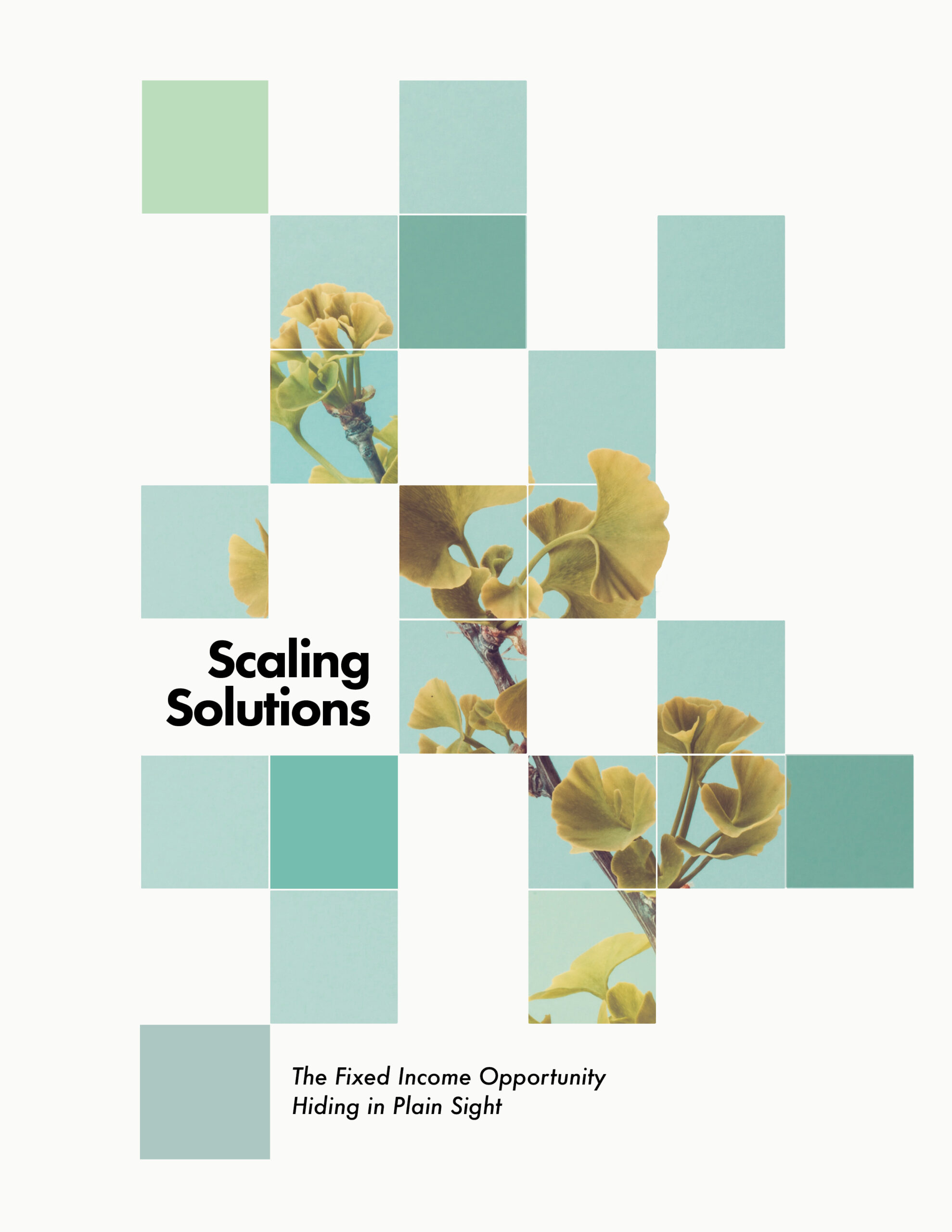Explore the new research report from Tideline, BlueMark, and Builders Vision
As global challenges grow more urgent and capital-intensive, the impact investing market is evolving to meet the moment. Scaling Solutions makes the case for fixed income as the next frontier in impact — a $140+ trillion asset class hiding in plain sight.
While traditionally prized for stability, fixed income investments hold immense untapped potential to drive social and environmental change at scale. From funding vaccine access to supporting disaster recovery and affordable housing, fixed income is already addressing urgent social and environmental challenges and could vastly increase the size of the impact investing market if more capital is mobilized with greater intention.
Scaling Solutions presents a new narrative for impact investing via fixed income and offers practical guidance for investors to act today, using the same standards and frameworks that are already widely used across the impact investing market. Featuring original research, case studies, and tactical allocator resources, this report is a must-read for those ready to unlock more capital for impact.
“The connection between bonds and investing in resilience remains opaque. The perception persists that fixed income is solely an asset class for risk mitigation and yield; it’s not solutions-oriented. Yet fixed income has always been the asset class of choice for scaling and sustaining proven projects, products and services — or, in other words, solutions you can count on. Fixed income… has the attributes that make the asset class an ideal anchor for any portfolio investing to build a future that’s resilient and prosperous.” – Noelle Laing, CIO of Builders Vision
Case Studies
FAQs
Who should read this report?
Scaling Solutions is primarily intended for asset allocators – particularly those coming from one of two vantage points: impact investors who have not yet explored fixed income, and investors who see fixed income as a compelling entry point into impact investing. The report is also a valuable resource for asset managers seeking to deepen their impact investing practice within this asset class, as well as for issuers, underwriters, and other stakeholders across the fixed income ecosystem who want to better understand how the asset class can be used to achieve meaningful social and environmental outcomes.
What is impact fixed income?
“Impact fixed income” refers to the investor practice of making investments in fixed income instruments (e.g., bonds, securitizations) that generate both financial returns and positive, measurable social or environmental outcomes. Impact fixed income approaches can be wide-ranging – encompassing investments in themes including affordable housing, clean energy, sustainable infrastructure, and access to essential services across different geographic regions and via various sub-asset classes (e.g., corporate and sovereign bonds, municipal bonds, asset-backed securities, etc.), in labeled or non-labeled securities.
How does impact fixed income differ from bonds that are labeled as green, sustainable, or social?
Impact fixed income is a holistic, investor-driven approach to impact that goes beyond selecting investments based on green, social, and sustainable (GSS) labeling at face value. While GSS bonds can be a component of an impact fixed income strategy, the approach can encompass a more expansive opportunity set that includes non-labeled bonds and general-purpose debt from mission-aligned issuers – provided that the opportunities have a clear and well-evidenced contribution to the investor’s impact objective. Impact fixed income demands clear intentionality, thorough due diligence on an investment’s potential for meaningful outcomes, a defined contribution thesis, and ongoing impact measurement. In essence, impact fixed income requires investors to conduct additional impact analysis on investible fixed income opportunities, above and beyond GSS labeling.
What makes fixed income a good tool for achieving impact?
Fixed income is a powerful tool for achieving impact because it offers a unique combination of scale, responsiveness, and precision. The market of fixed income opportunities with impact characteristics is growing rapidly and is supported by robust sustainability labeling regimes, regulations, and widely accepted standards that enhance transparency and build investor confidence. Investors also benefit from fixed income’s upfront transparency on use of proceeds, risk, returns, and metrics, making it easier to align investments with targeted, measurable impact goals across geographies and themes.
How do I get started in impact investing in fixed income?
This report equips investors with the knowledge and tools to get started today. It demonstrates that fixed income can deliver meaningful social and environmental outcomes alongside competitive financial returns, while offering access to a diverse investment universe. The report includes clear, adaptable frameworks aligned with leading impact investing standards to help investors navigate and evaluate fixed income opportunities. These are brought to life through case studies of asset managers already impact investing in this asset class, as well as a set of high-level, actionable tools tailored to asset allocators at different experience levels to support implementation and measurement across the investment lifecycle.
Is it possible to get competitive financial returns through impact investing in fixed income?
A growing body of evidence shows that fixed income strategies designed with impact objectives can deliver returns in line with traditional benchmarks, while also advancing measurable social and environmental outcomes. Many fixed income products with impact characteristics – such as green, social, and sustainability bonds – are structured and priced similarly to conventional bonds, and benefit from the same underlying market fundamentals. While the market for these products is young, emergent data shows that they generate similar returns to non-impact benchmarks. As the market matures, investors are increasingly able to build diversified fixed income portfolios that meet both their financial and impact goals without compromising on either.
Press
https://www.newprivatemarkets.com/fixed-income-can-triple-impact-investments-fairly-quickly/
https://impact-investor.com/new-paper-puts-forward-the-case-for-impact-fixed-income/


